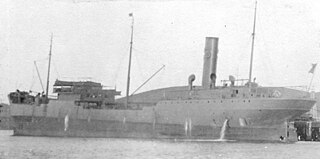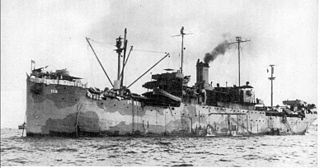
The second USS Abarenda (IX-131) was a storage tanker, one of many miscellaneous-class Navy vessel manned by the United States Coast Guard during World War II.
USS Arethusa (IX-135) began life as Gargoyle—a tanker built in 1921 at Oakland, Calif., by the Moore Shipbuilding Co. and was renamed Arethusa by the Navy and designated IX-135 on 3 November 1943; acquired by the Navy on 23 March 1944 from the War Shipping Administration on a bareboat basis for use as a mobile floating storage tanker; and placed in commission on that same day at Majuro Atoll, Marshall Islands, Lt. Walter J. Tross in command.

USS Alameda, was a United States Navy tanker in commission from 1919 to 1922. She was built as the civilian tanker SS Alameda, but transferred to the U.S. Navy after completion in 1919. She was sold for commercial service and operated under the names SS Olean and SS Sweep before she was transferred to the Navy again in World War II as USS Silver Cloud (IX-143).

USS Cossatot (AO-77) was a United States Navy World War II Type T2-SE-A1 tanker which served as a fleet oiler. Launched as SS Fort Necessity on 28 February 1943 by the Sun Shipbuilding & Dry Dock Co., Chester, Pennsylvania, under a Maritime Commission contract; sponsored by Mrs. W. Taylor; acquired by the Navy on 17 March 1943; and commissioned on 20 April 1943 Commander P. G. Beck, USNR, in command. It was named for a river in Arkansas.

SS Mission Solano was a Type T2-SE-A2 tanker built for the United States Maritime Commission during World War II. After the war she was acquired by the United States Navy as USS Mission Solano (AO-135). Later the tanker transferred to the Military Sea Transportation Service as USNS Mission Solano (T-AO-135). A Mission Buenaventura-class oiler, she was named for Mission San Francisco Solano, she was the only U.S. Naval vessel to bear the name.

The second USS Raccoon (IX-127), an Armadillo-class tanker designated an unclassified miscellaneous vessel, was the second ship of the United States Navy to be named for the raccoon. She was built as the Liberty ship J. C. W. Becham by the Maritime Commission and renamed Raccoon by the Navy on 27 October 1943. Her keel was laid down on 7 November 1943 by the Delta Shipbuilding Company, in New Orleans, Louisiana. She was launched on 23 December 1943 sponsored by Mrs. J. C. W. Becham, accepted from the War Shipping Administration under bareboat basis on 31 January 1944, and commissioned on 1 February 1944 with Lieutenant Michael E. Vallario, USNR, in command.
USS Armadillo (IX-111), the lead ship of her class of tanker was the only ship of the United States Navy to be named for the armadillo, an insect-eating mammal which has an armorlike shell encasing its back and head.
USS Panda (IX-125), an Armadillo-class tanker designated an unclassified miscellaneous vessel, was the only ship of the United States Navy to be named for the panda. Her keel was laid down as Opie Read in 1943 by Delta Shipbuilding Company, in New Orleans, Louisiana. She was renamed Panda on the 27 of October 1943 upon charter from the War Shipping Administration, accepted 5 January 1944, and commissioned on 6 January 1944, Lieutenant Commander William A. Porteous, Jr., in command.

USS Neosho (AO–48) was a Kennebec-class type T2 fleet oiler of the United States Navy. The ship was laid down on 8 July 1941, as SS Catawba, by the Bethlehem-Sparrows Point Shipyard Inc., Sparrows Point, Maryland. The purchase came under Maritime Commission contract number 145 for the Socony-Vacuum Oil Company, later renamed Mobil Oil.
USS Cache (AO-67) was a Type T2-SE-A1 Suamico-class fleet oiler of the United States Navy.

USS Cowanesque (AO-79) was a Type T2-SE-A1 Suamico-class fleet oiler of the United States Navy during World War II.

USS Cahaba (AO-82) was an Escambia-class replenishment oiler acquired by the United States Navy for use during World War II. She had the dangerous but necessary task of providing fuel to vessels in combat and non-combat areas primarily in the Pacific Ocean. For her brave efforts, she received eight battle stars during the war.
USS Anacostia (AO-94) was a Escambia-class replenishment oiler acquired by the United States Navy for use during World War II. She had the dangerous but necessary task of providing fuel to vessels in combat and non-combat areas. She served in the Pacific Ocean Theater of operations late in the war, and returned home proudly with one battle star.
USS Caney (AO-95) was an Escambia-class replenishment oiler acquired by the United States Navy for use during World War II. She had the dangerous but necessary task of providing fuel to vessels in combat and non-combat areas. She served in the Pacific Ocean Theatre of operations late in the war, and returned home proudly with two battle stars.

USS Chiwawa (AO-68) is a former T3-S-A1 Kennebec-class oiler constructed for the United States Navy during World War II. She was the only U.S. Navy ship named for the Chiwawa River in Washington.

USS Enoree (AO-69) was a Chiwawa-class oiler constructed for the United States Navy during World War II. She was the only U.S. Navy ship named for the Enoree River in South Carolina.

USS Kishwaukee (AOG-9) was a Patapsco-class gasoline tanker acquired by the U.S. Navy for the dangerous task of transporting gasoline to warships in the fleet, and to remote Navy stations.

USS Pembina (AK-200) – later known as USNS Pembina (T-AK-200) -- was an Alamosa-class cargo ship that was constructed for the U.S. Navy during the closing period of World War II. She supported the end-of-war Navy effort and was subsequently placed in service with the US Army under the Shipping Control Authority for the Japanese Merchant Marine with a Japanese crew in Yokosuka, Japan.

USS Ocelot (IX–110) was an unclassified miscellaneous vessel of the United States Navy, which served as the flagship of Service Squadron 10 in the Pacific War from late 1944, until she was wrecked in a typhoon in late 1945.
USS Clifton (IX-184) was a storage tanker that served in the United States Navy from 1945 to 1946 as an unclassified miscellaneous vessel.












